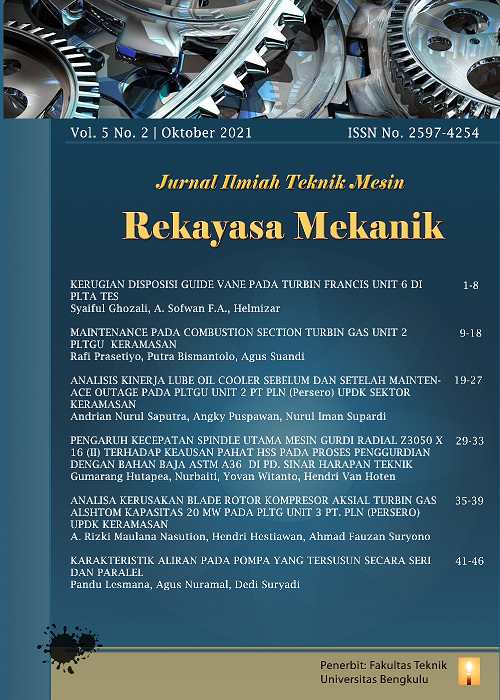Main Article Content
Abstract
Keywords
Article Details
References
- Widarto. 2008. Teknik pemesinan jilid 2. Jakarta: Direktorat Pembinaan Sekolah Menengah Kejuruan.
- Apri yandis. 2013. Deskripsi Profil PD. SINAR HARAPAN TEKNIK. Bengkulu.
- Achmad Arifin. 2016 Pengetahuan Dasar-Dasar Mesin Perkakas Dalam Pemesinan. http://achmadarifin.com/pengetahuan-dasar-mesin-perkakas-dalam pemesinan.
- Glossary of terms and definitions in the field of friction, wear and lubrication, Research Group on Wear of Engineering Materials, Organisation for EconomicCo-operation and Development, (1969). Reprinted in Wear Control Handbook (eds M.B. Petersonand W.O. Winer), American Society of Mechanical Engineers, 1980, pp. 1143–1303.
- Zum Gahr, K.H. (1987). Microstructure and Wear of Materials, Tribology Series, Elsevier, Amsterdam, pp. 132–148.
- Hokkirigawa, K. and Kato, K. (1989). Theoretical Estimation of Abrasive Wear Resistance Based on Microscopic Wear Mechanism, Wear of Materials (ed K.C.Ludema), ASME, New York, pp. 1–8.
- Stachowiak, Gwidon W. (2005). Wear–Materials, Mechanisms and Practice. John Wiley & Sons, Ltd., West Sussex, England.
References
Widarto. 2008. Teknik pemesinan jilid 2. Jakarta: Direktorat Pembinaan Sekolah Menengah Kejuruan.
Apri yandis. 2013. Deskripsi Profil PD. SINAR HARAPAN TEKNIK. Bengkulu.
Achmad Arifin. 2016 Pengetahuan Dasar-Dasar Mesin Perkakas Dalam Pemesinan. http://achmadarifin.com/pengetahuan-dasar-mesin-perkakas-dalam pemesinan.
Glossary of terms and definitions in the field of friction, wear and lubrication, Research Group on Wear of Engineering Materials, Organisation for EconomicCo-operation and Development, (1969). Reprinted in Wear Control Handbook (eds M.B. Petersonand W.O. Winer), American Society of Mechanical Engineers, 1980, pp. 1143–1303.
Zum Gahr, K.H. (1987). Microstructure and Wear of Materials, Tribology Series, Elsevier, Amsterdam, pp. 132–148.
Hokkirigawa, K. and Kato, K. (1989). Theoretical Estimation of Abrasive Wear Resistance Based on Microscopic Wear Mechanism, Wear of Materials (ed K.C.Ludema), ASME, New York, pp. 1–8.
Stachowiak, Gwidon W. (2005). Wear–Materials, Mechanisms and Practice. John Wiley & Sons, Ltd., West Sussex, England.

